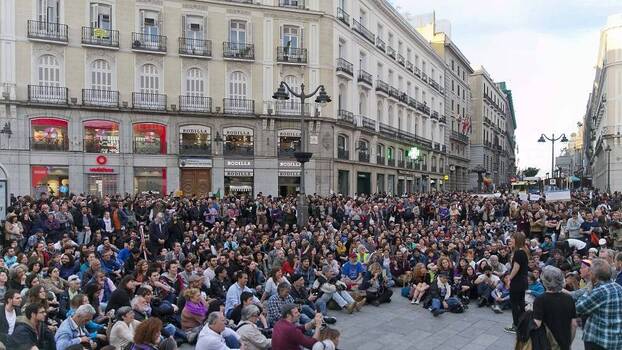
The defeat of Barcelona en Comú in the June 2023 local elections ended Ada Colau’s eight years as mayor of the city and marked the ebbing of the New Municipalist wave that swept Spain in 2015. That year saw the formation of citizens’ platforms across the country, which soon gained control of six of Spain’s seven largest cities. In 2020, a similar wave swept across the municipal elections in France before also receding. The action has now moved East, with a new municipalist wave rising in the Balkans and the citizens’ platform Mozemo gaining the Mayoralty of Zagreb and control of the city council in 2021. This shift provides an opportune moment to look at the lessons to be found in these New Municipalist experiments.
Gareth Brown is a researcher, consultant, union organizer, game designer, and activist with a background as an organization studies academic.
Keir Milburn is a writer, researcher, game designer, and consultant. He is co-director of Abundance, an organization focused on developing and implementing public–common partnerships. He also co-hosts the popular #ACFM podcast on Novara Media.
The term New Municipalism covers a variety of approaches that all aim to use municipal government and activism at the “municipal” level of scale to initiate broader practices of transformative social change. These approaches gained steam and became grouped together following the great financial crisis of 2008, as cities tried to push beyond the constrictions placed upon them by neoliberal austerity.
In the UK, new municipalist innovation was most strongly influenced by a trans-Atlantic exchange around the theory and practice of Community Wealth Building, in which local government procurement is refocused on the development of local, democratic economies. The bottom-up, citizens’ platform version of New Municipalism is distinct from, but not antagonistic to, the Community Wealth Building approach. It emerged out of the social movements of the 2010s, most notably Spain’s huge 15M movement that took the country by storm in 2011. The platforms were an attempt to bring the more participative democratic ethic valued in these movements into the more hierarchical structures of representative democracy that organizes the public sphere.
Our recent Rosa Luxemburg Foundation-funded report on the lessons of New Municipalism focuses on an innovative set of policies adopted by New Municipalist administrations in Barcelona and Naples. These policies, which are sometimes called public-civic, public community, or public-common partnerships, epitomize the attempt to reconcile the two approaches to democracy by bringing public assets, resources, and services under the control and sometimes ownership of organized communities. We think these have important lessons not only for how we might democratize the running of public assets and services, but also how we might democratize the wider economy.
They prove that participative, democratic community management of assets and public services can be effective and efficient, but they also show they can be beneficial for democracy more broadly. The operation of public-common partnerships builds constituencies for their own support and extension, while also developing the democratic capacities of those who participate in them.
Governing the Commons
The public sector gains its legitimacy from the representational nature of its democratic structures, in which the public votes for representatives who then govern in their stead. This is very different from the more direct and participatory forms of democracy usually adopted when governing the commons, or in other fora in which the ownership and governance of assets involves deep community involvement.
This poses two questions: Firstly, how can representative democracy and direct democracy work in tandem without the public subordinating the common to its organizational logic? Secondly, and relatedly, how do more participative and direct forms of democracy gain their own forms of legitimacy? When we talk about community governance of public assets, the question of legitimacy can be further refined: Why should this specific community, organized in this specific way, have the right to govern this specific asset?
In Barcelona, we looked at the Patrimonio Ciudadano (Citizens’ Assets) for Community Use and Management programme commissioned by the Barcelona en Comú administration and designed by the think tank IDRA. The programme, developed in close collaboration with an existing network of social solidarity projects, established a set of procedures and institutions to enable and facilitate the community self-management of public assets.
The first is a citizens’ asset board to allocate premises or land to community projects, although these decisions are still subject to political approval. A publicly available database of public assets is maintained to facilitate community access, and a technical office of civil servants was established to provide support and training to potential public-civic partnership projects. This support has been crucial to overcoming the critique made of the UK’s Big Society program that already well-resourced communities could gain proportionally more resources than poorer communities owing to imbalances in the time and capacity needed to access them.
To address the question of legitimacy, the programme created a new form of assessment called Community Balance. In the UK, we’re used to community ownership projects being assessed using social value metrics which turn the benefits of social activism into economic sums. In Barcelona, Community Balance acts as a supplement to social value metrics. It measures things such as a project’s rootedness in the community, its openness to participation, its democratic management, and so on.
How can representative democracy and direct democracy work in tandem without the public subordinating the common to its organizational logic? How do more participative and direct forms of democracy gain their own forms of legitimacy?
The Community Balance assessment serves two functions. It can help projects to improve by incentivizing more open participation, for instance, but it also functions as a source of legitimation. It identifies the legitimacy of community-governed public assets and services in the openness and non-exclusivity of their organization. This experience is so valuable because it emerged out of a perfect storm: a rare confluence in a city of vibrant social movements, a long history of community governance of public assets, and a sympathetic administration.
The policy of public-common partnerships in Italy came about in a different way, and for that reason holds lessons for the situation in which the Left generally finds itself today. The story we found in Naples begins in 2012 with the occupation of a cultural centre called L’ Asilo Filangieri. The occupation was initially planned as a short-term protest against the public-private partnership model then running the building, but the numbers who turned out for the open mass assemblies they held in the building opened up new possibilities.
The assemblies decided to run the building long term while building legitimacy, both political and legal, as they went. That assembly has met every week since, and over the years, it drew up a Declaration of Urban Civic and Collective Use, which outlines the principles upon which an organized community has the legal and moral right to use a public building. Interestingly, although their legal arguments are rooted in a clause of the Italian constitution, they came to very similar conclusions around openness and non-exclusivity of use as the case in Barcelona.
The declaration drawn up by the assembly took on a life of its own. It became both the constitution upon which the L’Asilo building still runs, and also the basis upon which Naples’s city council, and the sympathetic mayor Luigi de Magistris, drew up and passed a charter of the commons codifying the principles. The charter has since been adopted by other Italian cities, allowing many more buildings to be brought under civic use and run as commons.
Whereas in Barcelona the initiative came, at least partially, from the city’s administration, in Naples, the activists decided against directly joining the de Magistris administration, acting instead in an autonomous but collaborative manner, drawing up their own principles for their building’s usage before presenting them to the mayor based on their own merits. As the new municipalist and left-populist waves of the 2010s recedes in many parts of Europe, this seems to offer an important model of how you can build power when you’re out of power, at least electorally.
How We Win
Partnerships between local government and communities organized around commons are not straightforward. They require shifts in behaviour from both sides to bridge different organizational logics. They are, however, powerful tools for the project of defending and extending democracy against the creep of authoritarian oligarchy. That project, in turn, is the only route to a socially just Green transition in which the vast majority can identify and asset their interests against those who currently hold wealth and power.
The New Municipalist waves ebbed for a variety of reasons, some are specific and localized to the region or country involved, but others are shared. Any attempt to avoid a return to the neoliberal governmental norm needs to change the balance of forces by sparking a wider wave of democratization.
The general political lesson, then, is one captured by the theorist Stuart Hall in an earlier period. “We can envisage a ‘partnership’ between state and society”, he said, “so long as the initiative is always passing to society, so long as the monopoly over the management of social life does not come to a dead halt with the state elite, so long as the state itself is rooted in, constantly draws energy from, and is pushed actively, by popular forces.”
